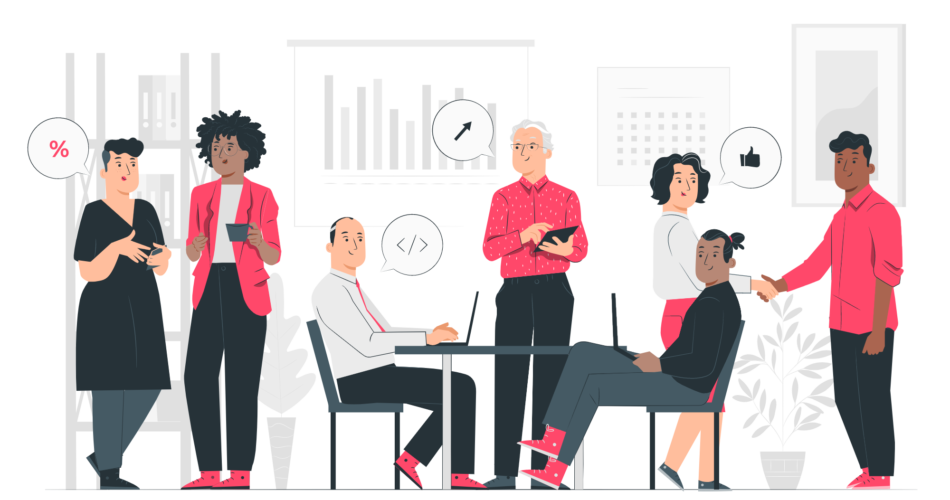Almost every company in the IT sector, whether small, medium, or large, has many departments that work together for the overall business growth. But have you ever thought, why so many teams or units are needed?
A well-designed organizational structure helps a software company streamline its work processes, increase productivity, and gain more profits and success. In addition, as various departments work on different aspects of a product or service, this structure fosters teamwork and collaboration, boosting efficiency and leveraging the company’s growth.
But for doing so, a correct organizational structure is of utmost importance. An improper structure can lead to miscommunication among teams, disrupting workflow and hindering growth. So, here, in this article, we will discuss the different departments of an IT enterprise and how they work.
Table of Contents
Sales and Marketing Department
The sales and marketing department is an integral unit of an IT enterprise. It sets realistic sales goals, annually, monthly, weekly, or daily. This particular contributes to product pricing, its launch, and distribution.
The sales team also sends surveys and requests for product reviews from customers. In addition, they keep looking for newer ways to upsell their products and services.

This unit tracks the latest trends and monitors competition to plan and execute marketing strategies for customer outreach and higher conversions. Also, it leverages social media marketing efforts, communicates with other units, and innovates optimum solutions for better business growth.
Admin Department
Now, the admin department is the one that helps an IT company run smoothly. The admin department does everything from maintaining office equipment like fax machines, telephones, and scanners, to updating the blog or website of a company to maintain a significant online presence.
Also, when the inventory runs low, this unit is the one that orders office supplies. It even performs online research and uses database software for inputting information about a company’s clients or employees.
Besides, the admin department prepares online conferences as well. It transcribes multiple kinds of information, stores them in a computer-based file, and manages office documentation by using computer-based documentation software.
Operations Department
The operations department makes sure that the production process is seamlessly completed from the beginning to the end. Hence, these processes need to align well with the functions and goals of other departments of the software company.
This unit offers constant oversight of the production process to ensure that employees systematically and efficiently perform their tasks.
Hence, the operations department is responsible for establishing a consensus among the employees and providing sufficient resources to managers for mentoring their subordinates. It also assesses the value of different business processes and enhances the performance of every department.
Quality Assurance Department
The quality assurance team in an IT company helps create and offer a quality product or service. Their tasks are not limited to regular bug searching or product testing, but they also troubleshoot technical glitches when needed.
They ensure that the development process’s quality and output remain intact. Hence, the QA team tests the product throughout all the SDLC or software development lifecycle phases.
This department also identifies the weaknesses in a product, combat those contingencies, and contribute to seamless product development.
Accounts and Finance Department
This department is solely responsible for maintaining and recording business transactions accurately in a systematic way so that they can be reviewed and retrieved at any time. In addition, it maintains internal controls adequately for safeguarding the company’s valuable resources.

Also, this team offers a basis for performance assessment and accountability across the company. They keep track of the costs incurred by the company and advise the modification of existing operations to reduce the operating expenses.
Besides, they support senior management in the decision-making process through correct financial data presentation.
Research and Development Department
The R&D department focuses on innovating newer services and products for a company, boosting its growth.
This team makes sure that the company produces top-quality products that offer it a competitive edge and eventually elevate the current price line.
This IT department operates on the long-term vision of the company. Thus, their projects may lead to trademarks, patents, or breakthrough discoveries with long-lasting benefits to the organization.
Learning and Development Department
A software company’s learning and development department offers several benefits that directly impact a company’s bottom line.
Training employees improve their productivity. Hence, this team helps IT companies gain and retain top talents who can contribute to the revenue and growth of the business.
The primary object of the learning and development team is to align employee performance with the goals of the organization. They identify the skill gaps among employees and teams. And based on that, they deliver training to bridge those gaps and leverage yield.
Human Resources Team
The HR or Human Resources team is a vital department for any organization. It maximizes employees’ productivity and protects a company from any problems that might take place in the workforce.

The primary responsibilities of this particular IT department include offering benefits and compensation, firing, and recruitment of newer employees. Besides, the team also needs to stay updated with the laws and regulations that may affect the company and its employees.
In other words, they focus on managing and utilizing human resources effectively and enhancing the enterprise’s creativity, flexibility, and innovation for gaining a competitive edge in the industry.
Customer Support Department
In the IT sector, the customer support department prioritizes customers facing troubles or needing assistance with a service or product they have bought from the company.

Also, the customer support team offers technical assistance to customers with certain products or services and answers all their queries regarding their experiences or purchases. Thus, the main objective of this department is to interact with customers with the necessary solutions and answers.
Security Department
The security department is responsible for maintaining and implementing organization-wide information security standards, policies, procedures, and guidelines. In addition, they facilitate security awareness and make sure that everyone is aware of their roles in keeping the security intact.
Thus, in short, this department offers adequate mechanisms for supporting the security program of an enterprise.
This team operates 24 hours from the security operations room, desk, or alarm room. Hence, they can offer prompt emergency service in an IT company whenever needed.
Conclusion
The list goes on, and several other departments exist in the IT sector. But the ones mentioned above are the primary units. Each of these departments has an equal contribution to the company in terms of their roles, and all of them share a common goal, i.e., to make the company reach the pinnacle of success.




